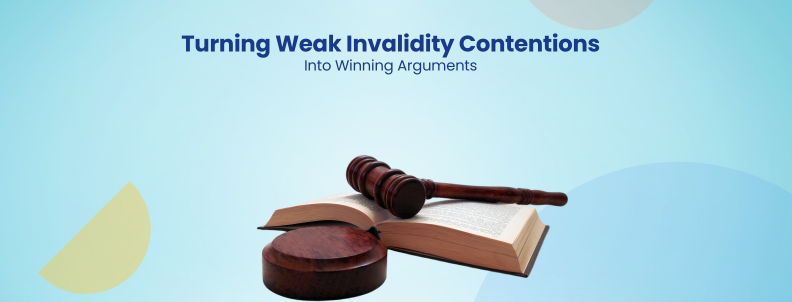Weak invalidity contentions delay proceedings and increase costs, adding unnecessary stress to a high-stakes situation. Worst of all, it turns even the winning cases into losing battles.
Minor oversights, even incomplete prior art information or errors in the procedural details, put the entire case at risk.
This article lists 5 strategies to create solid invalidity contentions that will turn a weak position into a winning one.
1. Understanding the company’s business goal
Before diving into technical details, consider the larger goal to avoid wasted time and effort. Is the goal to invalidate the patent as part of a defense strategy, or is this part of a significant licensing negotiation?
For example, one of our clients, NetSolutions, faced this challenge when they decided to invalidate a competitor’s patent. The patent, held by TCom Innovations, discussed improving signal quality in mobile networks. NetSolutions’ larger goal was to reduce costs before a new product launch and regain market share.
In this case, challenging the patent would save the client’s licensing fees and strengthen their position in the market. Since an out-of-court settlement was not in the picture, we prepared for counterarguments, which also impacted the prior art search strategy.
Analyzing the patent’s prosecution history, we discovered that TCom had narrowed its claims to overcome prior art rejections. This revealed vulnerabilities we could leverage.
The patent also lacked detailed technical implementations. As a result, we found earlier patents covering similar technology. TCom’s overly broad claims made building a solid invalidity case easier.
2. Speak the jury’s language with a technical expert on board
Using technical language will confuse a jury or judge who does not have deep expertise in the field. This weakens the case and makes key points harder to convey.
To address this, simplify complex terms so they’re accessible to a person having ordinary skill in the art (PHOSITA). Choose an expert witness who understands and can explain the technical aspects clearly. The Supreme Court has emphasized that PHOSITA relies on common sense, not technical jargon, so your arguments should too.
We worked with an expert witness to simplify complex terms in one case. Instead of saying “orthogonal frequency-division multiplexing,” the expert described it as “breaking data into smaller pieces to send it faster.” This made it easier for the court to follow the argument, regardless of their technical background.
The expert also highlighted practical flaws in the patented technology, such as poor bandwidth management, which leads to slower speeds during peak times. This common-sense explanation aligned with the court’s expectations and strengthened our invalidity argument.
3. Anticipate the opposition’s next move
A solid defense prepares for the arguments the opposing side will likely present. One effective strategy is to look at the patent’s history and pinpoint terms that were narrowly defined to get the patent approved.
In one case, the patent holder narrowly defined “signal tiering” as adjusting signal strength based solely on user density, ignoring environmental factors. This definition helped them overcome prior art rejections. But it also weakened their case.
We demonstrated that our client’s technology was beyond the patent’s scope by focusing on how physical obstructions, like buildings or terrain, affect signal strength. We also found earlier patents that covered “signal strength modulation based on environmental factors,” proving that the patented method was not novel.
Expecting the patent holder to rely on their narrow definitions, we prepared counterarguments. We showed how the patent failed to address real-world scenarios, weakening their case.
4. Follow local rules
When drafting invalidity contentions, strict adherence to local court rules is essential. Some courts require specific formats, such as charts for prior art references, while others allow references in appendices. Knowing and following these rules ensures a smooth process and avoids unnecessary delays.
5. Find the right time to present your arguments for maximum impact
The timing of arguments is crucial in patent litigation. Revealing key points too early might encourage settlement discussions and give the opposition time to counter. On the other hand, holding back for too long risks the opportunity for out-of-court settlements.
In one instance, a client considered disclosing their strongest invalidity arguments early in the case for a quick settlement. However, we suggested that doing so will allow the opposition to strengthen their defenses.
A phased approach was recommended. The client began by presenting broader, less controversial discrepancies in the patent claims. As the case progressed, pressure mounted, and the strongest points were held back strategically. Later, a detailed claim chart revealing significant overlap was presented during a critical hearing, ensuring the client’s strong foot in the game.
Conclusion
A strong patent litigation strategy depends on crafting thorough and well-documented invalidity contentions. By focusing on precise claim analysis, solid legal arguments, and strategic timing, the course of the case can be controlled, and the chances of success increase.
GreyB specializes in helping businesses navigate the complexities of innovation and intellectual property.
Partnering with a team like GreyB’s ensures you uncover growth opportunities, safeguard your IP, and stay ahead in today’s competitive landscape. We don’t just offer insights—we provide actionable strategies tailored to your unique needs, ensuring your innovation efforts are protected and strategically aligned with the future.
GreyB understands the complexities of staying ahead in today’s innovation landscape. We’re passionate about treating your challenges as our own, and our mission is to uncover the most valuable opportunities for your business.
Fill out the form below to start building a winning defense.
Authored by: Akshat Sharma

